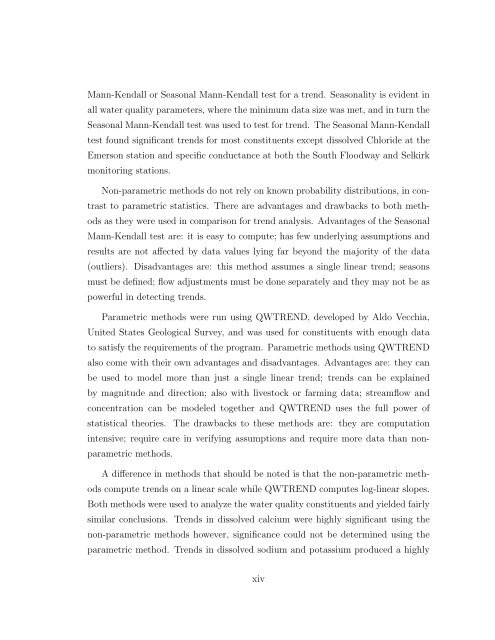Statistical Analysis of Trends in the Red River Over a 45 Year Period
Statistical Analysis of Trends in the Red River Over a 45 Year Period
Statistical Analysis of Trends in the Red River Over a 45 Year Period
You also want an ePaper? Increase the reach of your titles
YUMPU automatically turns print PDFs into web optimized ePapers that Google loves.
Mann-Kendall or Seasonal Mann-Kendall test for a trend. Seasonality is evident <strong>in</strong><br />
all water quality parameters, where <strong>the</strong> m<strong>in</strong>imum data size was met, and <strong>in</strong> turn <strong>the</strong><br />
Seasonal Mann-Kendall test was used to test for trend. The Seasonal Mann-Kendall<br />
test found significant trends for most constituents except dissolved Chloride at <strong>the</strong><br />
Emerson station and specific conductance at both <strong>the</strong> South Floodway and Selkirk<br />
monitor<strong>in</strong>g stations.<br />
Non-parametric methods do not rely on known probability distributions, <strong>in</strong> contrast<br />
to parametric statistics. There are advantages and drawbacks to both methods<br />
as <strong>the</strong>y were used <strong>in</strong> comparison for trend analysis. Advantages <strong>of</strong> <strong>the</strong> Seasonal<br />
Mann-Kendall test are: it is easy to compute; has few underly<strong>in</strong>g assumptions and<br />
results are not affected by data values ly<strong>in</strong>g far beyond <strong>the</strong> majority <strong>of</strong> <strong>the</strong> data<br />
(outliers). Disadvantages are: this method assumes a s<strong>in</strong>gle l<strong>in</strong>ear trend; seasons<br />
must be def<strong>in</strong>ed; flow adjustments must be done separately and <strong>the</strong>y may not be as<br />
powerful <strong>in</strong> detect<strong>in</strong>g trends.<br />
Parametric methods were run us<strong>in</strong>g QWTREND, developed by Aldo Vecchia,<br />
United States Geological Survey, and was used for constituents with enough data<br />
to satisfy <strong>the</strong> requirements <strong>of</strong> <strong>the</strong> program. Parametric methods us<strong>in</strong>g QWTREND<br />
also come with <strong>the</strong>ir own advantages and disadvantages. Advantages are: <strong>the</strong>y can<br />
be used to model more than just a s<strong>in</strong>gle l<strong>in</strong>ear trend; trends can be expla<strong>in</strong>ed<br />
by magnitude and direction; also with livestock or farm<strong>in</strong>g data; streamflow and<br />
concentration can be modeled toge<strong>the</strong>r and QWTREND uses <strong>the</strong> full power <strong>of</strong><br />
statistical <strong>the</strong>ories. The drawbacks to <strong>the</strong>se methods are: <strong>the</strong>y are computation<br />
<strong>in</strong>tensive; require care <strong>in</strong> verify<strong>in</strong>g assumptions and require more data than nonparametric<br />
methods.<br />
A difference <strong>in</strong> methods that should be noted is that <strong>the</strong> non-parametric methods<br />
compute trends on a l<strong>in</strong>ear scale while QWTREND computes log-l<strong>in</strong>ear slopes.<br />
Both methods were used to analyze <strong>the</strong> water quality constituents and yielded fairly<br />
similar conclusions. <strong>Trends</strong> <strong>in</strong> dissolved calcium were highly significant us<strong>in</strong>g <strong>the</strong><br />
non-parametric methods however, significance could not be determ<strong>in</strong>ed us<strong>in</strong>g <strong>the</strong><br />
parametric method. <strong>Trends</strong> <strong>in</strong> dissolved sodium and potassium produced a highly<br />
xiv
















